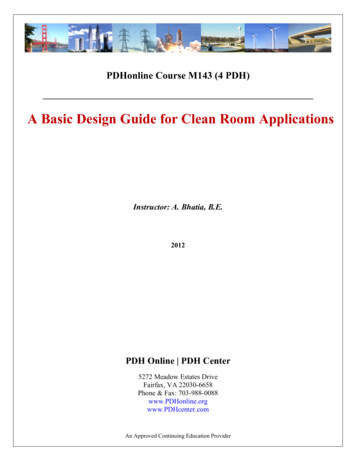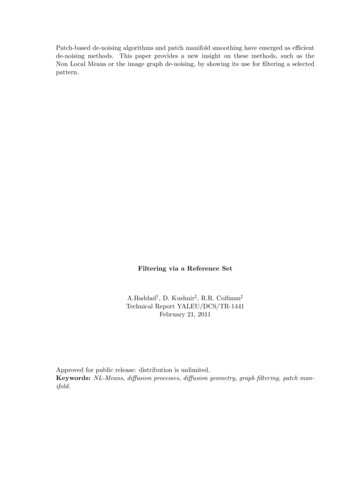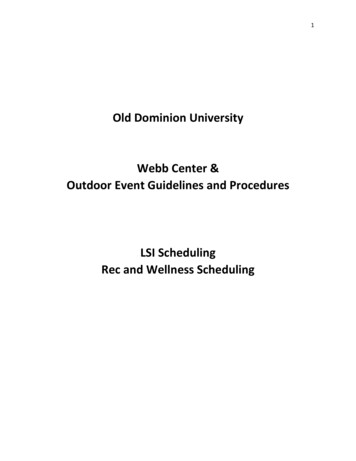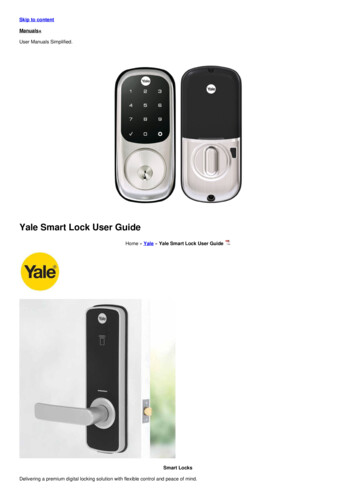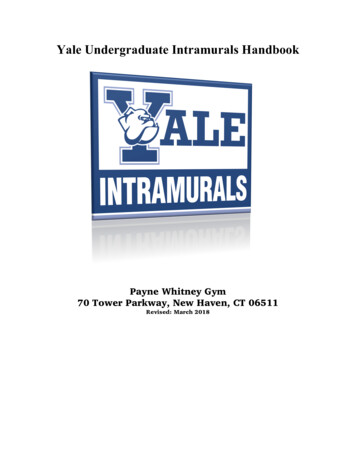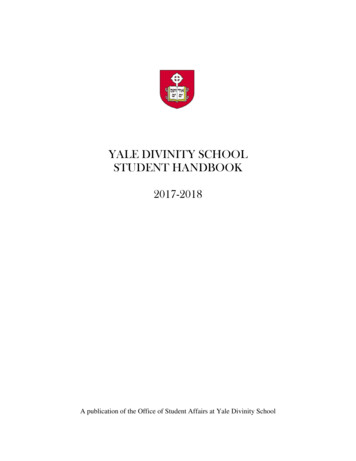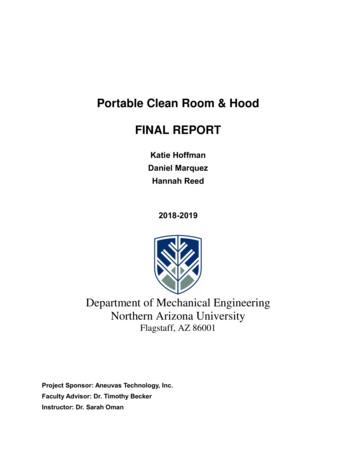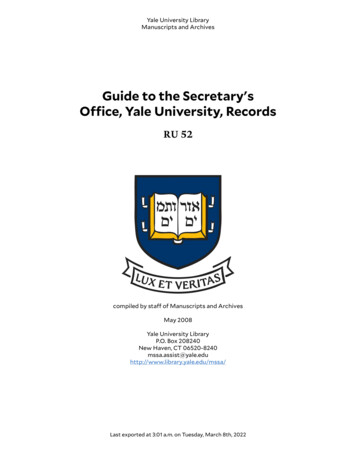
Transcription
Clean Room HandbookRev. 2.1.5Yale SEAS CleanroomA Yale University CORELaboratory1
Rev. 1.1Rev. 2.1Rev. 2.1.2Rev. 2.1.3Rev. 2.1.4issued 8/07issued 6/08issued 1/09issued 10/09issued 2/14Ammended requirements for qualificationUndergraduate requirementsExternal customersAmmended policy 5.1 User Fees and CostsResponsibility to Provost’s OfficeAmmended policy 5.6.1 Hours of operation8AM- 5PM Monday thru FridayAmmended policy 5.6.3 After HoursApproval for after hours to include staffDefinition of ‘buddy’Ammended policy 5.8.0 Policy ChangesFinal authority to cleanroom directorAmmended policy 5.8.1 Cleanroom CommitteeCommittee make up and responsibilitiesAmended Policy 6.3.0 Toxic Gas Monitoring systemResponse to low level alarmResponse to all alarms after hoursRev. 2.1.5issued 5/17Amended replace Coral with FOM for management softwareAmended application instructionsCopyright 2009 Yale UniversityAll Rights Reserved2
ContentsIntroductionBrief historyCleanroom SpecificationsOrganizational Chart1.0Requirements for qualification2.0Cleanroom Training2.1Intro to cleanrooms2.2Orientation and walkthrough2.3SEAS Personal contamination2.4Chemical safety and handling2.5Process bench protocols2.6Facilities Online Management (FOM)2.7Miscellaneous5.0SEAS Cleanroom Policies5.1User fees and costs5.2Time keeping5.3Visitors and guests5.4External customers5.5Precious metals5.6After hours5.7Discipline5.8Policy changes6.07.0SafetyProcess equipmenthttp://www.eng.yale.edu/cleanroom/3
The publication of this cleanroom user’s handbook ismotivated by the desire and need to inform and guide thenew or returning cleanroom user in the rules, features, andguidelines for the successful conduct of research in thefacility. This will be a live document; as our cleanroomorganization matures, and as we make the inevitablechanges and additions to the facility, the contents of thisguide will change with it.4
IntroductionBrief history of the Becton CRThe “original” Becton Cleanroom was built in 1988 for 1.2M.Its pertinent design specifications:2,600 square feetOne bay Class 100 with the remainder Class 1,000Temperature 68 4 FHumidity 40 5%Staff: 1 Technician/managerEntire budget paid by user feesBuilding facilities maintained by physical plantThe original faculty founders were Dick Barker, T.P. Ma, DanProber, and Bob WheelerOver the course of the last 20 or so years, this facility hasgone from suppoting five or six faculty members in 3departments to over 30 faculty in 8 departments and morethan 130 cleanroom users.Estimated research relying on cleanroom usage: 3-4 M/yrtotal (2004/05), with quantum computing alone accountingfor approx. 2 M/yr (2004/05), with 100% reliance on thecleanroom.In early 2005, Dean Fleury formed an Executive Committeecomposed of Profs. T.P. Ma, J. Han, and R. Schoelkopf. Thecommittee issued a report (6/05) finding significant problemswith Becton cleanroom. These problems included:1) Environmental systems failing-Air handler past useful life, accumulates water-Cleanroom environment no longer meets specs-Dehumidifier (DX coil) removed sometime in 20035
-Pneumatic controls antiquated, no logging of data2) Potentially serious safety issues-Toxic/flammable gas storage not up to code-Electrical code violations-Wet benches: too few, flammable, ventilationinadequate3) Tool set out of date, maintenance problematic-No plasma etching, mask making 4) Understaffed, no direct university support!The University responded in several ways:1) Two new CR staff positions were authorized andfunded by the Provost’s office2) The purchase of approx. 1.7M in new cleanroomtools was authorized and funded by the Provost’soffice3) A comprehensive cleanroom redesign was begun in2005. Midwest Cleanroom Associates (MCA) wereselected to serve as consultants and commissioningagents on the subsequent renovation project4) The major renovation project was begun 3/07 andcompleted by 09/075) Certification and commissioning completed by 10/076
Cleanroom Specifications2007 Yale FOE CR 2.0 Design SpecificationsTemperature:68 2 F sensed at 10 points, with remote telemetryand loggingRelative Humidity: 45 5 % sensed at 10 points, with remote telemetryand logging(source: Basis of Design, Midwest Cleanroom Associates, April 13, 2006)Total make up air flow, scfm17600Total exhaust flow, scfm16000Particle countsISO 5 “Class 100” 100 per ft3ISO 6 “Class 1000” 1000 per ft32 fixed particle counters with remotetelemetry and trendingDI waterRO qualityRO capacity, gallons/dayRO storage capacity, galDI Resistivity, Ώ-cmDI loop flow, gpmDI loop delivery pressureFinal filterResistivity MonitorsDI piping materialProcess chilled waterMax. flow, gpmMax. heat load, BTU/hSupply TemperatureΔ Pressuredissolved solids reduction by 96%Bacteria reduction by 99%Particulate removal down to 5 μm in size 440050018 x 106, with remote telemetry andlogging25, with duplex alternating distributionpumps90 psi at pump discharge0.2 μm, stainless steel housingsupply and return, temperaturecompensatedPVDF60180000 60 F, or just above dew point;adjustable, telemetered, and trended.adjustable, 10 psi minimum7
Compressed dry air80-100 psig, from building supply, duallead-lag sourceHouse nitrogenapprox 60 psig from liquid boiloffHouse vacuummin. 21” Hg, dual lead-lag pumps8
Organization ChartDeputyProvostAcademic, Scientific Issuesand PlanningClean RoomDirectorCleanRoom StaffClean Room Users9Dean ofEngineeringAdvisoryCommittee
1.0Requirements for qualificationUsers needing to use the cleanroom that have never been previouslyqualified for the Yale cleanroom.Graduate students, researchers, and faculty1. Obtain the approval of the principal investigator / faculty memberwho has agreed to be financially responsible for the user’scleanroom usage.2. Go to http://fom.yale.edu/fom/welcomeo Register with FOMo Special note for entering prox card numbers The prox card number is found on the back ofyour Yale ID badge, you will find it on the lowerleft hand corner, typically it will be yellow in colorwith a letter followed by five numbers. DO NOT enter letters (i.e. C-2175 enter as 2175)DO NOT enter preceding zeros (i.e. C-00190 enter as 190)ooooooEnter a valid PATEO accountIf your supervisor isn’t listed, please notify staff butcontinue to submit registrationLog into FOMUnder Yale SEAS Cleanroom, click on Resources inthis facilityClick on Becton Cleanroom A User Agreement pop up window will open Click on Facility Agreement, a separate tab willopen a PDF of the Cleanroom Handbook Go back to the FOM tab, click on I have readthe policy and agree with its content A New User Application Form will open, fill itout and click Apply We will contact you with scheduled class dates,in the meantime, read the Cleanroom Handbook and complete online courses.Within a day or two, when you log into FOM the nexttime A pop up window will open, Safety TrainingRequired, it will list required certificates Click on certificate name, it will open anotherwindow with link to online training10
Completion of the three EH&S online courses isrequired prior to cleanroom class3. Attend an in-house orientation provided by cleanroom staff, tocover the following topics: Mechanics of cleanroom entry/exit: gowning, cardaccess Characteristics of CR areas, air pressure, particlecount Process bays, service bays, identification andprotocols4. Classroom and lab training for safety and chemical handling. PPE requirements Emergency response protocols Chemical handling Proper use of each of the chemical process benchesand hotplates5. Pass a written exam. The exam will cover items from (5) through(7) above. The exam will be administered after the completion of theprevious items. The exam will be graded by the cleanroom staff.Those not passing the exam will be allowed sufficient time to reviewthe appropriate materials (this handbook, online course work, etc)before retaking the exam.6. Attend and participate in a cleanroom walkthrough by acleanroom staff member. The items to be demonstrated will include(at a minimum): Prox card entry and exit protocol Proper gowning / degowning Location of safety equipment, PPE, andsuppliesLocation of spill kits and first aidLocation of supplies and chemicals Location of ringdown phones and alarms Proper hazardous waste labeling Coral scheduling and equipment enabling11
7. Additional individual one on one training is required to qualify forapproval to use process tools and systems, please see a staffmember to schedule training.8. Anyone who has previously been qualified for access to thecleanroom and has less than 30 hours of active cleanroom time per12 month period, will need the approval of the cleanroom manager,and review process equipment and procedures with a staff member,in order to maintain active status.Undergraduate studentsAll undergraduate student researchers desiring to have access to thecleanroom must be at the SENIOR undergraduate level as verified fromtheir transcript and at least 20 years of age.1. Students must interview with the cleanroom management toestablish their maturity, skills and capability in regard tocleanroom operations. Any reservations will be brought to theattention of the sponsoring faculty member.2. Once approved by the cleanroom management, all studentsmust take all safety training courses as required by cleanroommanagement and must pass with a grade of 70% minimum.3. After senior level students pass the courses, faculty responsiblefor the senior undergraduate student MUST arrange for them tobe accompanied by an EXPERIENCED graduate student orpostdoc (also under the associated faculty member’ssupervision) during EACH of their entire sessions in thecleanroom. Cleanroom staff will not be responsible for thedirect supervision of these students. Ultimately, the sponsoringfaculty member is responsible for all their student researchers.Of course, faculty members are also welcome to come into thecleanroom and monitor their students directly as well.12
4. Access for these senior level undergraduate students will beduring weekdays only, Mon-Fri between 8 AM and 5 PM.5. An email from the student’s sponsor verifying that the studentmeets these conditions should be made to the CleanroomDirector and Associate Director.13
External customers and external affiliated researchersAny non-Yale researchers interested in using the cleanroom,must contact the cleanroom director, who will determine if thereis an appropriate association to allow the use of universitylaboratories.14
2.0Cleanroom Training15
2.1Intro to cleanroomsA Basic Introduction to Clean RoomsBy Roger McFaddenTechnical Director, Coastwide echnical Articles/Cleaning theCleanroom.htm, 7/2007. Reproduced in part)A cleanroom is a controlled environment where productsare manufactured. It is a room in which the concentration of airborneparticles is controlled to specified limits. Eliminating sub-micron airbornecontamination is really a process of control. These contaminants aregenerated by people, process, facilities and equipment. They must becontinually removed from the air. The level to which these particles needto be removed depends upon the standards required. The mostfrequently used standard is the Federal Standard 209E. The 209E is adocument that establishes standard classes of air cleanliness forairborne particulate levels in cleanrooms and clean zones. Strict rulesand procedures are followed to prevent contamination of the product.The only way to control contamination is to control the totalenvironment. Air flow rates and direction, pressurization, temperature,humidity and specialized filtration all need to be tightly controlled. Andthe sources of these particles need to controlled or eliminated wheneverpossible. There is more to a clean room than air filters. Cleanrooms areplanned and manufactured using strict protocol and methods. They arefrequently found in electronics, pharmaceutical, biopharmaceutical,medical device industries and other critical manufacturing environments.It only takes a quick monitor of the air in a cleanroom comparedto a typical office building to see the difference. Typical office building aircontains from 500,000 to 1,000,000 particles (0.5 microns or larger) percubic foot of air. A Class 100 cleanroom is designed to never allow more16
than 100 particles (0.5 microns or larger) per cubic foot of air. Class 1000and Class 10,000 cleanrooms are designed to limit particles to 1000 and10,000 respectively.A human hair is about 75-100 microns in diameter. A particle200 times smaller (0.5 micron) than the human hair can cause majordisaster in a cleanroom. Contamination can lead to expensive downtimeand increased production costs. In fact, the billion dollar NASA HubbleSpace Telescope was damaged and did not perform as designedbecause of a particle smaller than 0.5 microns.Once a cleanroom is built it must be maintained and cleaned tothe same high standards. This handbook has been prepared to giveprofessional cleaning staff information about how to clean the cleanroom.What is Contamination?Contamination is a process or act that causes materials orsurfaces to be soiled with contaminating substances. There are twobroad categories of surface contaminants: film type and particulates.These contaminants can produce a “killer defect” in a miniature circuit.Film contaminants of only 10 nm (nanometers) can drastically reducecoating adhesion on a wafer or chip. It is widely accepted that particles of0.5 microns or larger are the target. However, some industries are nowtargeting smaller particles.A partial list of contaminants is found below. Any of these can bethe source for killing a circuit. Preventing these contaminants fromentering the cleanroom environment is the objective. It requires acommitment by everyone entering the cleanroom to make it happen.Professional cleaning personnel need to be aware of the importance ofcontrolling contaminants. Strict procedures should be followed wheneverentering or cleaning a cleanroom. Compromise is not acceptable whencleaning in a cleanroom.Sources of ContaminationThis is a partial list of some of the commonly knowncontaminants that can cause problems in some cleanroomenvironments. It has been found that many of these contaminants aregenerated from five basic sources. The facilities, people, tools, fluids andthe product being manufactured can all contribute to contamination.Review this list to gain a better understanding of where contaminationoriginates.17
1.FacilitiesWalls, floors and ceilingsPaint and coatingsConstruction material (sheet rock, saw dust etc.)Air conditioning debrisRoom air and vaporsSpills and leaks2.PeopleSkin flakes and oilCosmetics and perfumeSpittleClothing debris (lint, fibers etc.)Hair3. Tool GeneratedFriction and wear particlesLubricants and emissionsVibrationsBrooms, mops and dusters4.FluidsParticulates floating in airBacteria, organics and moistureFloor finishes or coatingsCleaning chemicalsPlasticizers (outgasses)Deionized water5.Product generatedSilicon chipsQuartz flakesCleanroom debrisAluminum particles18
Key Elements of Contamination ControlWe will look at several areas of concern to get a better idea ofthe overall picture of contamination control. These are the things thatneed to be considered when providing an effective contamination controlprogram.HEPA (High Efficiency Particulate Air Filter) - These filters areextremely important for maintaining contamination control. They filterparticles as small as 0.3 microns with a 99.97% minimum particlecollective efficiency.CLEANROOM ARCHITECTURE - Cleanrooms are designed to achieveand maintain an airflow in which essentially the entire body of air within aconfined area moves with uniform velocity along parellel flow lines. Thisair flow is called laminar flow. The more restriction of air flow the moreturbulence. Turbulence can cause particle movement.FILTRATION - In addition to the HEPA filters commonly used incleanrooms, there are a number of other filtration mechanisms used toremove particles from gases and liquids. These filters are essential forproviding effective contamination control.CLEANING - Cleaning is an essential element of contamination control.Decisions need to made about the details of cleanroom maintenance andcleaning. Applications and procedures need to be written and agreedupon by cleanroom management and contractors (if used). There aremany problems associated with cleaning. Managers need to answer thefollowing questions before proceeding with any cleanroom cleaningprogram:1.2.3.4.5.What is clean?How is clean measured?What cleaning materials can be used in the cleanroom?When can the cleanroom be cleaned?How frequent does it need to be cleaned?CLEANROOM GARMENTS - The requirements for cleanroom garmentswill vary from location to location. It is important to know the localgarment requirements of the cleanroom management. Gloves, facemasks and head covers are standard in nearly every cleanroomenvironment. Smocks are being used more and more. Jump suits arerequired in very clean environments.19
HUMANS IN CLEANROOMS - There are both physical andpsychological concerns when humans are present in cleanrooms.Physical behavior like fast motion and horseplay can increasecontamination. Psychological concerns like room temperature, humidity,claustrophobia, odors and workplace attitude are important. Below areseveral ways people produce contamination:1. Body Regenerative Processes-- Skin flakes, oils, perspiration andhair.2. Behavior-- Rate of movement, sneezing and coughing.3. Attitude-- Work habits and communciation between workers.People are a major source of contamination in the cleanroom.Look at the people activities listed below. Notice the number of particlesproduced per minute during these activities.PEOPLE ACTIVITYPARTICLES/MINUTE (0.3 micronsand larger)Motionless (Standing or Seated)100,000Walking about 2 mph5,000,000Walking about 3.5 mph7,000,000Walking about 5 mph10,000,000Horseplay100,000,000COMMODITIES - Care is taken when selecting and using commodityitems in cleanrooms. Wipers, cleanroom paper and pens and othersupplies that service the cleanroom should be carefully screened andselected. Review of the local cleanroom requirements for approving andtaking these items into the cleanroom are essential. In fact, manycleanroom managers will have approval lists of these types of items.COSMETICS - Many cosmetics contain sodium, magnesium, silicon,calcium, potassium or iron. These chemicals can create damagingparticles. Cleanroom managers may ban or restrict cosmetics in thecleanroom. This is usually dependent upon the threat to the productbeing made in the cleanroom. A recent mirror on a space telescope wasfogged up from the cologne that was present in the cleanroom.20
MEASUREMENT AND INSTRUMENTATION - Some importantmeasurements related to contamination control are particle count, airflow & velocity, humidity, temperature and surface cleanliness.Cleanroom managers usually have specific standards and/or instrumentsto measure these factors.ELECTROSTATIC DISCHARGE (ESD) - When two surfaces rubtogether an electrical charge can be created. Moving air creates acharge. People touching surfaces or walking across the floor can createa triboelectric charge. Special care is taken to use ESD protectivematerials to prevent damage from ESD. Cleaning managers should workwith their personnel to understand where these conditions may bepresent and how to prevent them.General Cleanroom RegulationsBelow is a list of general regulations recommended as a minimum for thesuccessful operation of a cleanroom. All professional cleaning personnelshould be aware and follow these regulations at all times.1. All personal items such as keys, watches, rings, matches, lightersand cigarettes should be stored in the personal locker outside thegowning room.2. Valuable personal Items such as wallets may be permitted in thecleanroom provided they are NEVER removed from beneath thecleanroom garments.3.NO eating, smoking or gum chewing allowed inside the cleanroom.4. Only garments approved for the cleanroom should be worn whenentering.5. NO cosmetics shall be worn in the cleanrooms. This includes: rouge,lipstick, eye shadow, eyebrow pencil, mascara, eye liner, false eyelashes, fingernail polish, hair spray, mousse, or the heavy use ofaerosols, after shaves and perfumes.6.Only approved cleanroom paper shall be allowed in the cleanroom.7.Approved ball point pens shall be the only writing tool used.21
8. Use of paper or fabric towels is prohibited. Use of hand dryersequipped with HEPA filters is suggested.9. Gloves or finger cots should not be allowed to touch any item orsurface that has not been thoroughly cleaned.10. Only approved gloves, finger cots (powder-free), pliers, tweezersshould be used tohandle product. Finger prints can be a major source of contamination onsome products.11. Solvent contact with the bare skin should be avoided. They canremove skin oils and increase skin flaking.12. Approved skin lotions or lanolin based soaps are sometimesallowed. These can reduce skin flaking.13. All tools, containers and fixtures used in the cleaning processshould be cleaned to the same degree as the cleanroom surfaces. All ofthese items are a source of contamination.14. NO tool should be allowed to rest on the surface of a bench ortable. It should be place on a cleanroom wiper.15. Only cleanroom approved wipers are allowed to be used. Thewipers must be approved for the Class of cleanroom being cleaned.16. ALL equipment, materials and containers introduced into a sterilefacility must be subjected to stringent sterilization prior to entrance.17. NO ONE who is physically ill, especially with respiratory or stomachdisorders, may enter a sterile room. This is a good practice in anycleanroom environment.Personal Actions Prohibited in Cleanrooms1.2.3.4.5.6.Fast motions such as running, walking fast or horseplay.Sitting or leaning on equipment or work surfaces.Writing on equipment or garments.Removal of items from beneath the cleanroom garments.Wearing the cleanroom garment outside the cleanroom.Wearing torn or soiled garments.22
2.2Orientation WalkthroughMinimal List of Items to be Covered during an initial CleanroomWalkthrough1. Cleanroom entry and exit protocols2. ISO5/class 100 and ISO6/class 1000 areas3. service bays, process bays4. differential pressures between areas5. particle counters6. fire extinguishers7. eyewashes and safety showers8. ringdown/emergency phones9. emergency gas off buttons10. hazardous gas alarm lights, detectors, and status panel11. wet process benches – location, purpose12. doors – entry, emergency exit, service bay, sliding23
2.3SEAS CR Personal Contamination Control1. EntryBefore entering the cleanroom, ensure that you have: eye protection[see section 6.0 , “PPE”], and that you are suitably attired (longpants/trousers, full-coverage shoes, no sandals/flip-flops, no highheels). Be sure to leave your MP3/iPod players in your office as well– they are inappropriate for work in the cleanroom, where payingattention to your environment is important for your safety and thesafety of others.Enter the cleanroom using your Yale ID Proxcard. The door willswing open for you, once your card has authenticated you. If you areentering while other people are entering or leaving, be sure to proxyour card (you’ll hear the card reader beep) even if the door isalready open, as this “logs” you in to the cleanroom.The first thing you’ll do is walk over a tacky mat. If the mat is gettingdirty, don’t hesitate to pull up the next sheet.If you are bringing in an item to place in the passthrough: You willfind a supply of lab wipes, and a spray bottle of IPA on the rack nearthe passthrough. Use the spray and the wipes to clean the itembefore placing it in the passthrough. At this point, think about yourcell phone – if you are going to need it in the cleanroom, wipe itdown and place it in the passthrough. Once you are gowned up, youwon’t be able to pull it out of your pocket if it rings.Notice the oval-shaped knob next to the passthrough door. This knoboperates the door interlock. Turn it counterclockwise to allow “your”door to open. When you close the door, turn the knob clockwise –this now allows the door on the cleanroom side to operate. You willfind a similar knob on the cleanroom side, and it has the samefunction.Next, before donning the blue shoe covers, make use of the shoecleaner, located near the entry door. Use it to remove the dirt onyour shoes, and then pull the shoe covers over your shoes.Now put on a pair of vinyl gloves. You will wear these while gowning.Also put on the bouffant hair cover, tucking your hair underneath if24
appropriate. If you have a beard or moustache (more than two daysgrowth for most men), also put on a beard cover.If you do not already have a gown and a hood hanging up in thegowning room, choose one of each now, of the appropriate size,from the rack. Sizes are labeled, and range from small on the left to3XL on the right (small to XL for hoods).Now you’re ready to step through the door to the gowning room, andonto the next tacky mat. If it’s getting dirty, please pull up the nextsheet. (Clearly, if the shoe cleaner and the shoe covers are doingtheir job, it will take a while for this mat to get dirty!)We gown up in “top-down” fashion. First put on the hood, ensuringthe snaps face outward. Tuck in your hair. Fasten the hood closure,and adjust the fit snaps as needed. A full-length mirror is available inthe gowning room to help you make sure you have the hood on right,all your hair is tucked in properly, etc.Next, step into the coverall, while preventing the coverall fromcontacting the floor as much as possible. This takes some practice todo well. Fasten the coverall with the front zipper, ensuring the hoodtails are completely tucked in to the neck of the coverall. Use the fulllength mirror to verify that you are “tucked in” completely.Finally, put on the boots over your blue shoe covers. Use theadjustable strap to secure the lower part of the boot against your footand shoe. Tuck the coverall into the top part of the boot, fasten thetop of the boot to the bottom of the coverall with the snaps provided,and secure the top strap snugly with its snap.Select the appropriate glove for your intended activity in thecleanroom. The blue nitrile gloves are appropriate for most chemicalwork. The vinyl gloves, for some, are more comfortable and allow abit more tactile feedback, but are not appropriate for any chemicalwork.Finally, recheck your gowning in the full-length mirror. If you noticeanything amiss, fix it now before stepping onto the last tacky mat andinto the cleanroom.25
2. ExitThe degowning procedure is essentially the reverse of the gowningprocedure. While still gloved, remove your garments in “bottom-up”fashion – remove the boots, then the coverall (again being careful tonot let it contact the floor). Hang up the coverall on your hangar. Youcan now snap your boots to the bottoms of the coverall legs to keepall your garments together. Finally, remove the hood, and snap it tothe coverall as well.Next, step out into the entryway and retrieve your possessions fromthe passthrough (remembering to unlock/lock the door interlock asbefore). Finally, remove and dispose of the blue shoe covers, yourvinyl gloves, and your hair and beard cover.To operate the hallway door, prox your ID card on the pad adjacentto the door. The door will operate automatically. This also “logs” youout of the cleanroom.26
2.4Chemical Safety and Handling ProceduresThe following document provides detailed instructions for every phase ofchemical handling in the Yale Cleanroom from storage through disposal.These procedures are designed to ensure the safety of everyone whouses the facility as well as to comply with federal and state regulations.Everyone who is admitted to the facility should be familiar with theseprocedures. Reading and knowing these procedures in no way qualifiesyou to enter or do any work in the cleanroom, although it is a prerequisite. Further, some equipment discussed in this document, namelythe CMOS hood, has additional procedural requirements that should notsupersede these procedures but must be followed in addition.Fresh Chemicals Storage and TransportingBottles of fresh chemicals are to be stored in one of the two chemicalpass-through cabinets or in the small cabinets under the proper benches.The chemical bottles should be wiped down prior to being placed in thepass-through from the outside hallway to minimize particulates. Bottlesof fresh acid or caustic chemicals other than developer should betransported from the cabinet to the hoods using a rubber bucket and oneheavy nitrile glove. This allows the user to have one free hand to openthe door and one protected hand to carry the bucket. Bottles should bereturned to the proper storage location immediately after use. Rubberbuckets should be left near the pass through cabinets.Acids:Fresh acids should be stored in the trays on the 2nd and 3rdshelves of the corrosives pass-through. There is also room for 8 bottles of acid under the Acid Hood. To avoid unnecessarysearching for a particular acid, commonly used acids will have aspecific location in one of these cabinets and the cabinets will belabeled with this information. These chemicals and theirlocations are designated on the Chemical Storage Chart. Otherbottles must be stored in the corrosives cabinet. Over time, wemay find that the frequently used chemical list changes and wewill adjust the Chemical Storage Chart accordingly.Bases/Caustics:Fresh bases and caustic-based chemicals should be stored inthe trays on the top shelf of the corrosives pass-through. Thisincludes developers as well as strong bases. There is room for 8 bottles of caustics under
cleanroom and has less than 30 hours of active cleanroom time per 12 month period, will need the approval of the cleanroom manager, and review process equipment and procedures with a staff member, in order to maintain active status. Undergraduate students . All undergraduate student researchers desiring to have access to the

